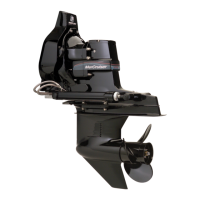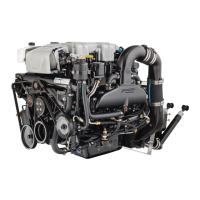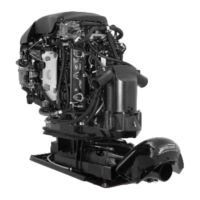Propeller Selection
IMPORTANT: Choosing the correct propeller allows the engine to run at its
specified maximum wide‑open throttle RPM. Use an accurate service
tachometer to verify engine operating RPM.
It is the boat manufacturer and/or the selling dealer's responsibility to equip the
power package with the correct propellers. Specified engine wide‑open throttle
(WOT) and operating RPM range are listed in Specifications.
IMPORTANT: All Mercury Racing engines have an RPM rev‑limiter that is set
to an upper (or limited) RPM. This limit is slightly above the normal operating
range of the engine and is designed to help prevent damage from excessive
engine RPM. Once the RPM drops into the recommended operating RPM
range, normal engine operation resumes.
Select a propeller that allows the engine to operate in the upper half of the
recommended full throttle RPM range with the boat normally loaded (refer to
Specifications).
If full throttle operation is below the recommended range, change the propeller
to prevent loss of performance and possible engine damage. On the other
hand, operating an engine above the recommended operating RPM range
causes higher than normal wear or damage. "Propeller lines normally are
designed so that the next size pitch will change engine RPM by 300 to 500. For
every 1" of pitch change, the effect will be approximately 200 RPM."
RPM loss may require changing to a lower pitch propeller due to the
following conditions:
• Operating in warmer weather and greater humidity.
• Operating in a higher elevation.
• Operating with a damaged propeller or dirty boat bottom.
• Operating with increased load (additional passengers, pulling skiers, etc.).
Conditions That Lower Engine Performance
The following conditions lower engine performance and cannot be
compensated by the engine fuel or electronic management systems.
• Above sea level elevations.
• High temperature.
• Low barometric pressure.
• High humidity.
The conditions listed above reduce air density to the engine which in turn
reduces the following:
• Boost pressure on supercharged engines.
• Horsepower and torque throughout the RPM range.
• Peak RPM.
• Cranking compression.
CONDITIONS AFFECTING OPERATION
eng 41
